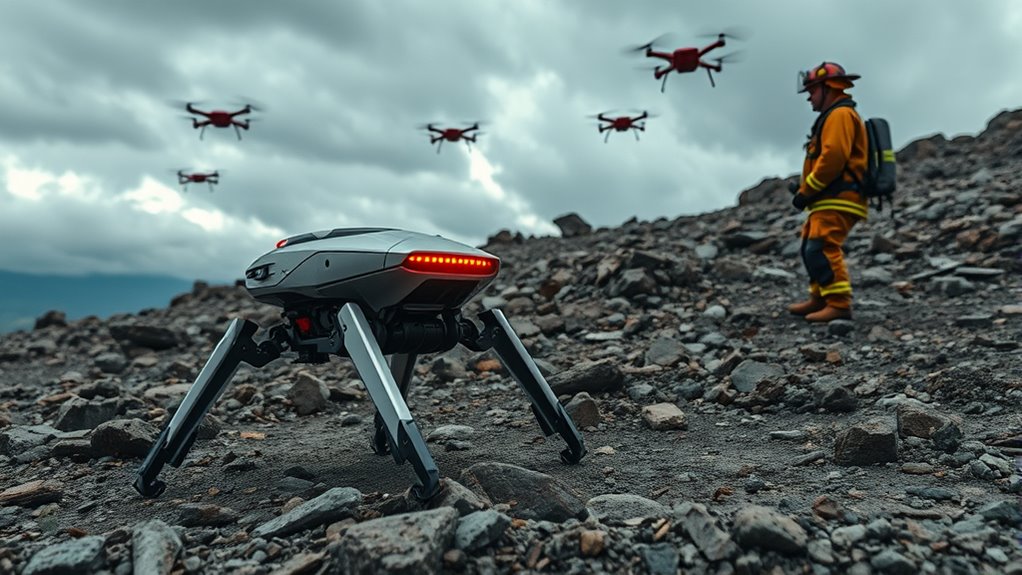Robotics play a essential role in search and rescue efforts by quickly accessing dangerous or hard-to-reach areas, increasing the chances of finding survivors. They come in various types, like crawling or flying robots, equipped with sensors and AI to detect signs of life and navigate unpredictable terrains. Their advanced technology enables faster, safer rescues while reducing risks to human responders. To discover how these innovations transform emergency responses, keep exploring the incredible capabilities of rescue robots.
Key Takeaways
- Rescue robots navigate hazardous environments autonomously, enabling access to areas unsafe for human responders.
- Advanced sensors and AI technologies improve victim detection and environmental assessment during rescue missions.
- Mobility features like wheels, tracks, and legs allow rescue robots to traverse debris, water, and uneven terrains effectively.
- Real-time data processing and mapping facilitate quick decision-making and efficient search operations.
- Deployment of rescue robots enhances safety, speeds up rescue efforts, and reduces risks for human rescuers.
Types of Rescue Robots and Their Functions
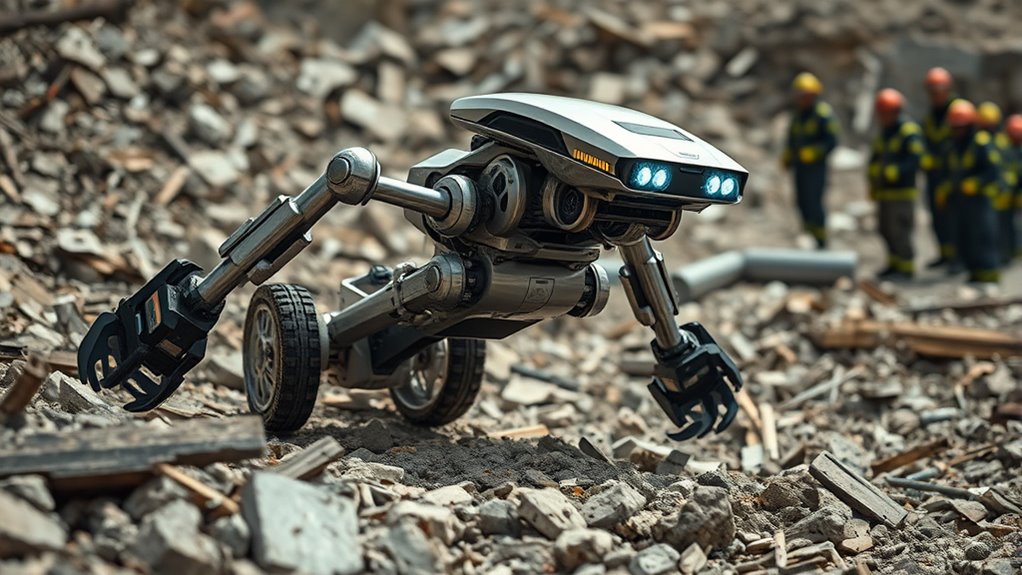
Rescue robots come in various types, each designed to perform specific tasks in disaster zones. You’ll find search robot types that excel at maneuvering debris and locating survivors, using sensors and cameras to scan difficult-to-reach areas. These robots can crawl, roll, or fly into tight spaces where humans can’t go safely. Rescue drone functions are also crucial; they provide aerial views of the scene, mapping out the area quickly and efficiently. Drones can deliver supplies or drop sensors to detect signs of life beneath rubble. Whether ground-based or airborne, these robots enhance rescue efforts by providing critical information, reducing risks for human responders, and speeding up the search process in chaotic, hazardous environments. The integration of advanced technology and design in these robots significantly boosts their effectiveness in emergency situations. Additionally, incorporating rescue-specific features such as thermal imaging and obstacle avoidance further improves their capability to operate effectively in complex environments. The use of specialized sensors also allows these robots to detect movement or heat signatures that might indicate trapped survivors. Moreover, ongoing innovations in artificial intelligence can improve robots’ decision-making skills, making rescue operations even more efficient.
Furthermore, the development of adaptable robotic frameworks enables these machines to be customized for various disaster scenarios, increasing their versatility and utility.
Technological Advancements Enhancing Search Capabilities
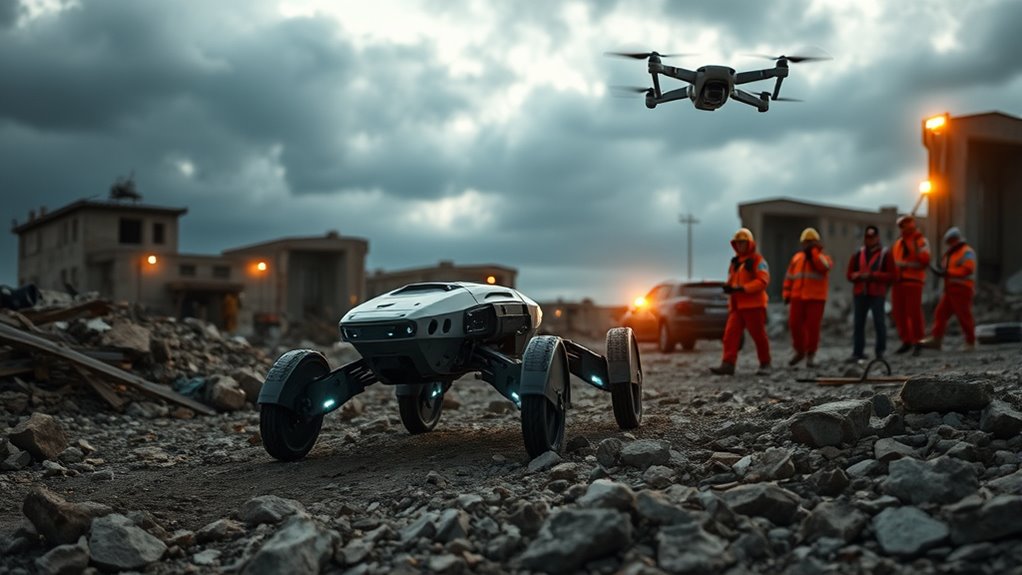
Advances in sensor technologies allow search robots to detect signs of life even in challenging environments. Autonomous navigation systems enable them to move efficiently through debris without human input. Enhanced data processing helps analyze collected information quickly, improving decision-making during rescues. Additionally, understanding the importance of interior design vs. decorating principles can inform the development of more user-friendly robotic interfaces and environments. Recognizing the influence of creativity and innovation in technology design can further enhance the effectiveness of rescue operations by fostering adaptable and intuitive robotic solutions.
Improved Sensor Technologies
Recent technological breakthroughs have considerably enhanced the sensors used in search and rescue robotics, enabling more accurate and faster detection of victims. Improved sensor calibration ensures that measurements remain precise even in challenging environments, increasing reliability during operations. Advanced sensors now provide better obstacle detection, allowing robots to navigate complex terrains safely and efficiently. These innovations reduce false alarms and improve target identification, speeding up rescue efforts. Enhanced sensitivity in thermal and acoustic sensors helps detect victims hidden beneath debris or in low-visibility conditions. The integration of these refined sensors means your rescue robots can operate more effectively, providing real-time data that accelerates decision-making. Additionally, the development of sensor durability ensures that equipment remains functional under harsh conditions, further enhancing operational effectiveness. Furthermore, vibrational detection capabilities can assist in locating victims through subtle environmental cues, increasing rescue success rates. Overall, these technological advancements notably boost the capabilities of search and rescue robots, making responses quicker, safer, and more accurate.
Autonomous Navigation Systems
Autonomous navigation systems have rapidly transformed search and rescue operations by enabling robots to traverse complex and unpredictable environments without human intervention. These systems rely on advanced mapping algorithms to create real-time 3D maps of their surroundings, helping robots understand their environment quickly. Obstacle avoidance is vital, allowing robots to detect and navigate around debris, unstable surfaces, or narrow passages safely. With improved sensors and sophisticated algorithms, you can trust these systems to maintain a steady course even in chaotic settings. This technology reduces the need for constant human control, speeds up search efforts, and increases safety for rescue teams. As a result, robots become more effective at locating victims in challenging terrains, making rescue missions faster, safer, and more efficient. Notably, the integration of high critical acclaim and box office success in related media highlights the importance of cutting-edge technology in entertainment and practical applications alike.
Enhanced Data Processing
Enhanced data processing technologies considerably boost the effectiveness of search and rescue robots by allowing them to interpret and analyze vast amounts of sensor information rapidly. This advancement enables real-time data analysis, helping you identify signs of survivors or hazards faster. With augmented processing, robots can generate real-time visualization of their surroundings, providing clear, actionable insights. This is particularly important given the diverse operational environments rescue robots encounter, which demand adaptable processing capabilities. Additionally, high refresh rates ensure smoother operation and more accurate tracking of fast-moving objects or individuals. Furthermore, the integration of advanced algorithms allows for improved pattern recognition and decision support, making rescue operations more efficient. Given the importance of AI safety measures, continuous monitoring and robust safety protocols are essential to prevent potential malfunctions during rescue missions. Incorporating robust data security is also vital to protect sensitive information collected during operations and maintain trust in robotic systems.
Operating Environments and Mobility Features
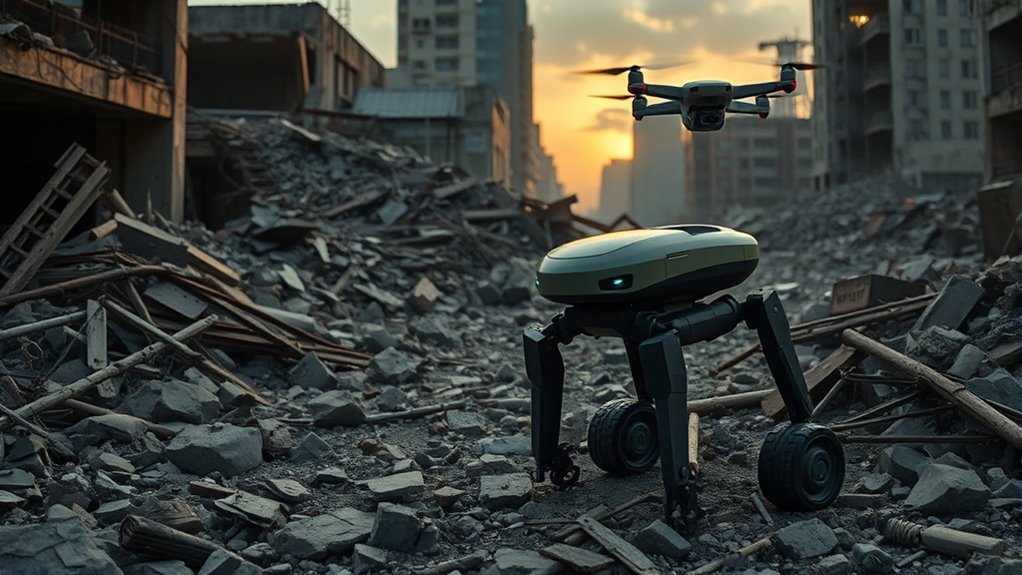
Operating environments for search and rescue robots can vary widely, from collapsed buildings and underground tunnels to flooded areas and rugged terrains. In these conditions, terrain adaptability is essential, allowing robots to navigate diverse surfaces effectively. You’ll find that obstacle negotiation is a key feature, helping robots overcome debris, uneven ground, and other barriers efficiently. Many rescue robots are equipped with wheels, tracks, or leg-like appendages to enhance mobility across challenging terrains. You need robots that can adapt quickly to unpredictable environments, maintaining stability and mobility even when faced with steep slopes, rubble, or water. You’ll find that terrain adaptability is crucial for reaching victims faster, providing vital assistance in environments where human access is limited or dangerous. Incorporating adaptability in design ensures that rescue robots can handle sudden environmental changes, improving overall mission success. Additionally, mobility features such as adjustable suspension systems and versatile locomotion methods further enhance a robot’s ability to operate effectively in complex rescue scenarios. Moreover, integrating skilled navigation systems can significantly improve the robot’s ability to maneuver through unpredictable environments efficiently.
Integration of Artificial Intelligence in Rescue Missions

Artificial intelligence dramatically improves rescue missions by enabling robots to make better decisions in complex situations. You’ll see robots with enhanced autonomous navigation that can efficiently explore unpredictable terrains. These advances mean faster, safer rescues with less human intervention. Additionally, dynamic communication exercises can be integrated into training protocols to improve team coordination and responsiveness during rescue operations. Incorporating advanced sensors and data processing further enhances robots’ ability to assess environments accurately and adapt to changing conditions. Recognizing store hours and operational timings can also optimize rescue efforts by coordinating with local facilities and resources to ensure prompt assistance. For example, understanding the hours of local stores and facilities allows rescue teams to plan effectively, especially when coordinating with nearby centers. Moreover, understanding dog names can help in training search and rescue dogs to respond effectively in different scenarios.
Enhanced Decision-Making Capabilities
Integrating artificial intelligence into rescue missions markedly boosts decision-making capabilities, allowing robots to analyze complex data rapidly and accurately. This enhancement enables quicker assessments, prioritization, and response strategies, essential in time-sensitive situations. Improved human-robot interaction ensures operators can interpret AI-driven insights effectively, fostering trust and collaboration. However, ethical considerations must guide AI deployment, ensuring decisions respect human safety and rights. Your understanding of these factors is fundamental for responsible integration.
- AI aids in real-time hazard detection and assessment
- Rapid data processing improves situational awareness
- Decision transparency enhances human trust
- Ethical frameworks prevent misuse or bias
- Collaboration between humans and robots becomes seamless
Autonomous Navigation Improvements
How do rescue robots maneuver complex, unpredictable environments without human guidance? They use advanced autonomous navigation systems powered by artificial intelligence. These systems enable robots to adapt to diverse terrains by analyzing sensor data for terrain adaptation, ensuring they move efficiently across rubble, mud, or uneven surfaces. Obstacle avoidance algorithms help them detect and bypass hazards like debris or unstable structures in real time. AI-driven mapping and path planning allow the robots to make split-second decisions, optimizing their routes and avoiding dead ends. This integration of AI enhances their ability to operate independently, reducing the need for human control. As a result, rescue robots become more effective in reaching victims and navigating hazardous environments safely and swiftly.
Benefits of Robotics in Emergency Response
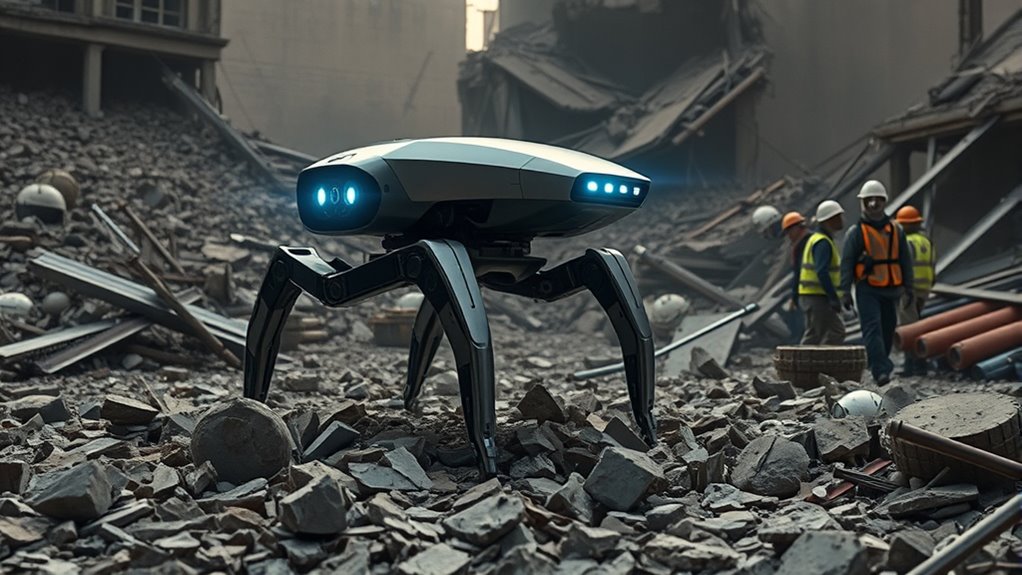
Robotics markedly enhance emergency response efforts by providing safer and more efficient ways to locate and assist victims. They reduce risks to human responders while increasing speed and accuracy in disaster scenarios. Robots can access hazardous environments, saving lives and minimizing damage. Their cost efficiency means agencies can deploy resources more effectively, reducing overall expenses. Additionally, robots improve human safety by limiting exposure to dangerous conditions, such as collapsing structures or toxic fumes.
Robots enhance safety and efficiency in disaster response, accessing hazardous areas and reducing risks to human rescuers.
- Swiftly reach inaccessible areas
- Minimize risk to rescue teams
- Operate in hazardous environments
- Increase response speed and accuracy
- Lower long-term response costs
Challenges and Limitations of Rescue Robots
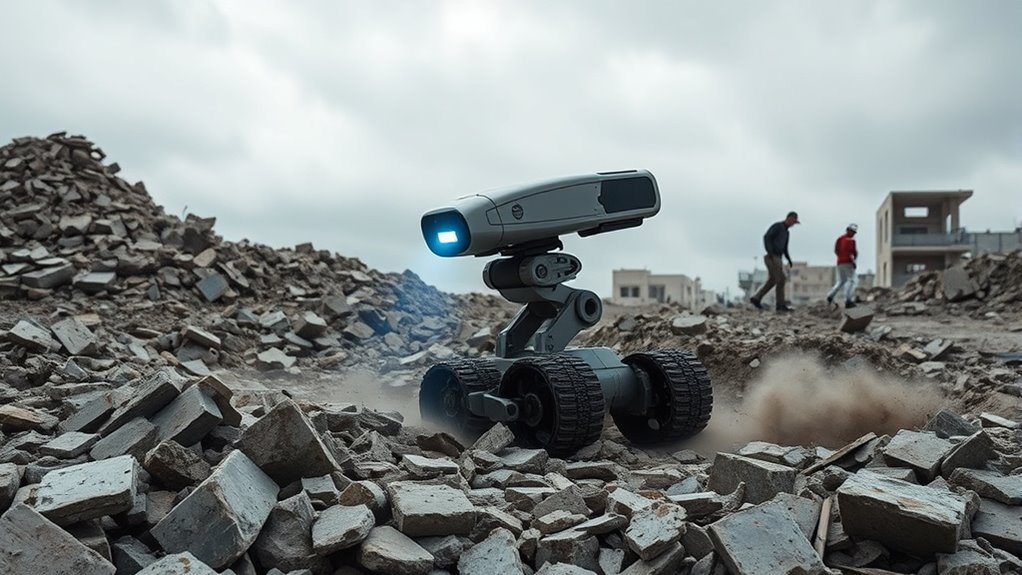
What are the main hurdles that rescue robots face in emergency situations? One major challenge is maneuvering unpredictable and hazardous environments, which can hinder their effectiveness. Limited battery life and hardware durability also pose significant obstacles, restricting operational time and reliability. Ethical concerns arise around decision-making processes—should robots prioritize certain victims over others? Funding challenges further limit deployment, as developing advanced rescue robots requires substantial investment, often with uncertain returns. Additionally, high costs can restrict access to cutting-edge technology, especially for smaller agencies. These limitations mean rescue robots aren’t yet universally reliable or affordable, preventing their widespread adoption. Overcoming these challenges involves balancing technological innovation with ethical considerations and securing sustainable funding to enhance their capabilities.
Future Trends and Innovations in Rescue Robotics
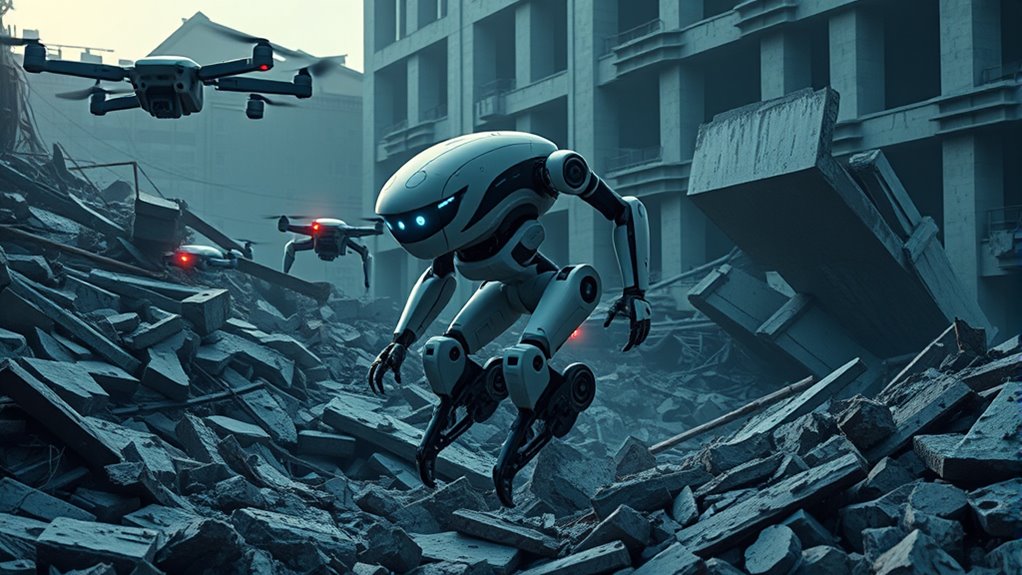
Advancements in technology are paving the way for smarter, more adaptable rescue robots that can better handle the chaos of disaster zones. Future innovations will focus on increasing autonomy, improving sensor accuracy, and enhancing real-time decision-making. However, as these robots evolve, you’ll need to contemplate robot ethics—ensuring they’re used responsibly and safely. Funding challenges remain a hurdle, requiring sustained investment for development and deployment. Innovations such as modular designs, AI-driven navigation, and improved communication systems will make rescue robots more effective. You should also anticipate increased collaboration across industries, integrating robotics with drone technology and human responders. These trends promise to transform search and rescue operations, making them faster, safer, and more efficient. Staying informed will be key to leveraging these cutting-edge advancements.
Frequently Asked Questions
How Cost-Effective Are Rescue Robots Compared to Human Teams?
You might wonder how rescue robots compare to human teams in cost-effectiveness. When you do a budget analysis, you’ll find that robots often have higher upfront costs but lower long-term expenses due to reduced personnel needs and quicker deployment. The cost comparison shows that, over time, robots can save money, especially in dangerous or hard-to-reach areas, making them a smart investment for efficient rescue operations.
What Training Is Required for Operators of Rescue Robots?
You’ll need specialized training in robot operation and emergency protocols to effectively handle rescue robots. This includes understanding the robot’s controls, sensors, and navigation systems, as well as safety procedures during search and rescue missions. While some might think it’s complex, hands-on practice and thorough courses make it manageable. Proper training ensures you can operate the robot confidently, respond swiftly in emergencies, and maximize the robot’s potential to save lives.
How Do Rescue Robots Handle Unpredictable or Dynamic Environments?
You rely on rescue robots to handle unpredictable environments through advanced sensor adaptability and sophisticated navigation algorithms. These robots constantly process real-time data from sensors, allowing them to adapt to changing conditions like debris or unstable surfaces. Their navigation algorithms help them plot safe paths, avoid obstacles, and make quick decisions, ensuring effective search and rescue efforts even in dynamic, chaotic settings.
What Ethical Considerations Arise With Deploying Rescue Robots?
Imagine guiding a rescue robot into a collapsed building, trusting it to make split-second decisions. Now, consider the ethical concerns that come with deploying these machines. You must address privacy concerns, ensuring they respect victims’ personal spaces. Also, question who holds decision-making autonomy—should the robot act independently or follow human commands? Balancing safety, ethics, and trust is essential to responsible rescue operations with robots.
How Do Rescue Robots Coordinate With Human Rescuers?
You can see that rescue robots coordinate with human rescuers through effective robot communication, ensuring seamless teamwork. They navigate obstacles using advanced obstacle navigation systems, which help them maneuver through debris and challenging terrain. By maintaining clear communication, you can trust that robots support your efforts efficiently, providing real-time data and assistance. This coordination enhances rescue operations, making them safer and more effective for everyone involved.
Conclusion
As you explore the evolving world of rescue robotics, remember they’re the guiding stars in the night sky, illuminating the path through chaos. These machines bring hope, bridging gaps where humans can’t reach, and revolutionizing emergency response. While challenges exist, ongoing innovations promise a brighter future. Embrace the potential of rescue robots—they’re the lighthouse helping us navigate through stormy seas toward safer horizons.

